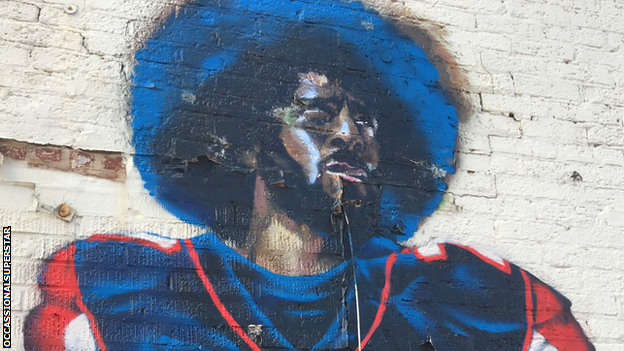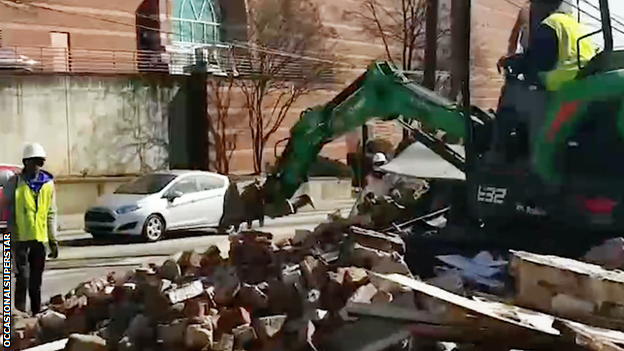Colin Kaepernick mural: Fabian Williams on how artists came together in Atlanta
- Published
Super Bowl 53: Why Atlanta artist Occasional Superstar paints murals of Colin Kaepernick
When an iconic mural of Colin Kaepernick was bulldozed on the first day of Black History Month in February 2019, local artists came together and worked tirelessly to paint his image across Atlanta.
"We can't keep doing this," artist Fabian Williams says. "I'm ready for new problems. I know that black lives are valuable and all lives are valuable, but let's put it in the books and move on."
You will find Williams' work across Atlanta - from 60ft murals of iconic figures such as civil rights activists Hosea Williams, Martin Luther King Jr and Malcolm X, to boxing legend Muhammad Ali and former San Francisco 49ers quarterback Kaepernick, who Williams describes as a civil rights icon.
With Atlanta considered the beating heart of black culture in the United States, it seems fitting to showcase some of the most influential black activists throughout history there. Describing the city, Grammy-winning artist Jermaine Dupri said: "This is Wakanda."

Colin Kaepernick started kneeling during the US national anthem in 2016 in protest against racial injustice
BBC Sport met Williams more than a year ago, before the bulldozing, and spent the day filming with him across the city, including in a quiet part of town where the Kaepernick mural stood and had become something of a local landmark.
"I was driving past a few days after we'd filmed with you and I saw bulldozers tearing it down," Williams says. "The legs were still up but the wall was gone. It was shocking. It took a minute to register.
"This was the first day of Black History Month in America. You mean to tell me you're tearing down the building with Colin Kaepernick, who is protesting against police brutality and systemic racism, on this day?"
"To me, art is communication. So when you destroy a piece of work on a certain day, you are communicating how you feel about that work, about that subject matter, about that person.
"That's how everybody took it. I was like: 'They're obviously talking to us - they're talking to black America.'"

Williams painted the mural, which showed Kaepernick in an Atlanta Falcons uniform, on an abandoned building in 2017
Williams met the owner of the building, who said he had been put under pressure to demolish it.
He also discovered the building was on the route NFL teams would regularly take to the Atlanta Falcons' stadium, and believes the pressure came from a higher power.
"They said the building was a hazard to the community," Williams says. "But they left the debris there for 30 days, in a community with plenty of children. It defied the city's demolition code and, as far as I know, nothing ever happened. That takes power.
"I was just surprised that they went there. They could have just painted over it. They wanted to destroy that building and there is nothing there to this day but a slab."
The woman with a plan
Ash Nash, who was managing Williams at the time, wanted to respond to the strength of feeling in the city, which is where the idea for the KaeperBowl came from.
"He [Williams] was just like: 'The building's gone, the building's gone. There's bulldozers stomping on it,'" said Nash, founder of Atlanta-based Power Haus Creative.
"The community kept reaching out like: 'What are you going to do?' That mural was a staple in the community and people related to it for so many things like social justice.
"I really wanted to make some noise."

"It was beautiful and the whole city came out to support it, like they were waiting on somebody or something to activate"
Planned for Super Bowl Sunday, KaeperBowl had seven notable street artists, led by Williams, from across Atlanta, using their unique styles to paint eight Kaepernick murals across the city over the course of three days.
Nash worked tirelessly for 72 hours to organise the event, from gaining permission from building owners to arranging supplies. The average mural can cost anywhere between $7,000 and $70,000 (£5,000-£55,000).
"I got up around 1am [on Super Bowl Sunday] and wanted to get a head start on everybody so I could set the bar on the level of art I expected, so I worked till around 5am," Williams says.
"I wanted something to motivate people as there was a lot of pressure on us. When people woke up that first morning and saw the first mural, it put a fire under people and that's what made them really get involved.
"It was something that just felt right. It felt like this was the proper response. It was beautiful and the whole city came out to support it, like they were waiting on somebody or something to activate."
Williams along with seven notable artists painted Kaepernick's image across the city
Meeting Colin Kaepernick
Kaepernick's team got in touch with Nash and Williams and invited them to his Know Your Rights camp alongside activists such as Benjamin Crump (lawyer to Trayvon Martin, who was shot dead in 2012), Malcolm X's daughter, Attallah Shabazz, and more than 500 underprivileged youths.
"One of the things I said was: 'Do you know who you are to people? Do you know the weight of what you're doing?' And he was like: 'Kind of, but I'm learning,'" says Williams.
"He really cares about the people he represents and the struggle he's taken on by uplifting people through challenging the morality of what we're doing as a nation, and it's working."
With the KaeperBowl raising more than $10,000 (£7,934) in just two days, Williams was able to create Bloom, a non-profit organisation which aims to improve underprivileged areas of the city by providing sustainable food sources.
"We're making mini-systems of self-governance because a lot of these communities are left to starve and we're looking at food like an area of independence," he says.
"If the city's not going to step in and make sure these people are helped, we've got to do it. It's not like it takes a lot of money or time, you just need to actually care."

"He's a humble dude" - Williams meets Kaepernick's at the Know Your Rights camp
The fashion stylist supporting Kaepernick in his fight against racial injustice